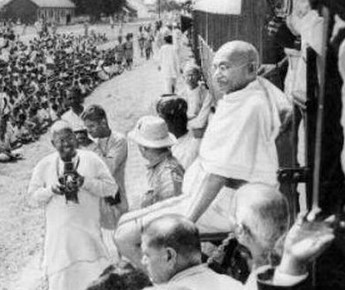By Sugeeswara Senadhira
Colombo, January 30 (Ceylon Today): Mahatma Gandhi, the apostle of peace and non-violence, was shot dead exactly 75 years ago, on 30 January 1948, five days before Sri Lanka’s Independence and slightly short of six months after the success of the nonviolent movement for India’s Independence led by him.
The first Prime Minister of India, Jawaharlal Nehru sobbed at the funeral saying: “What is the use of my government, which could not protect our nation’s biggest treasure?”
Mohandas Karamchand Gandhi’s strategy was a combination of truth, sacrifice, nonviolence, selfless service and cooperation. Gandhi said that one should be brave and not a coward. One should present ones’ views, suggestions and thoughts without being violent.
Truth as a Weapon
Gandhi advocated that one should fight a war with the weapons of truth and nonviolence and changed the policy path of India’s freedom struggle. Radical leaders such as Subhas Chandra Bose believed that the only way to freedom was to defeat the British through an armed struggle. With Hitler’s Germany and Mussolini’s Italy he formed an Indian National Army in Japan to fight the allied forces in Indonesia, Singapore and Malaysia. But eventually, Gandhi’s nonviolent policy proved to be correct.
Sri Lanka’s independence struggle was also heavily influenced by Mahatma Gandhi’s policy of nonviolence. The independence struggle in Sri Lanka manifested different forms from time to time marked by heroic rebel movements, courageous noncooperation movements and determined nonviolent struggles.
The first act of defiance of foreign domination was even before the British flag was unfurled in Kandy in 1815. Sri Lanka’s dislike of foreign domination and the spirit to resist began on 2 March 1815 itself when Venerable Wariyapola Sri Sumangala Thera removed the British flag when it was hoisted a few hours before the surrender agreement was signed on that mournful day.
Rebellion against foreign rule
Three years after the surrender in 1815, the first rebellion against foreign rule erupted in Uva-Wellassa. The British dispatched troops under the command of chieftain Monarawila Keppetipola Disawe, who, as a proud Kandyan leader, refused to fight his countrymen and took over the rebellion’s leadership. The brave soldier he was, Keppetipola Disawe sent back his British troops without imprisoning them or punishing them.
British troops were brought in from other colonies to suppress this struggle, which they eventually did with their superior numbers and firepower. All the rebel leaders were executed and their properties were confiscated. However, the valiant rebel leader Monarawila Keppetipola Disawe won even the admiration of the British for his bravery, as he was unafraid and unbowed up to the point of his beheading at the Bogambara grounds in Kandy. The British took his skull to England for scientific experiments as they were astonished by his unusual courage, which was beyond the capacity of an ordinary human being.
At the same time, the colonial army devastated the entire Uva Wellassa region. By the time the ruthless suppression was over, there was not a single house or paddy field standing, as everything had been burnt down. Not a single youth was left after the brutal massacre.
Although the rebellion was crushed, the British could not extinguish the embers of the spirit of independence. In 1848, the Matale Rebellion, led by Veera Puran Appu and Gongalegoda Banda, erupted. It started as a protest against the unfair acquisition of land and the imposition of new taxes by the British. Later, the rebels attacked the British military camp in Matale. That rebellion was also ruthlessly crushed by the British with superior arms and trained troops. Heroic leaders, Puran Appu and Gongalegoda Banda and scores of others were executed.
After the devastation, deaths, untold sacrifices and miseries suffered in the two rebellions, there was a lull until the nonviolent non-cooperation movement commenced in the 20 th. century.
The galaxy of leaders from Anagarika Dharmapala, D.B. Jayatilaka, F.R. and D.S. Senanayake, Henry Pedris, T.B. Jayah, Ponnambalam Ramanathan, Ponnambalam Arunachalam, N.M. Perera, Philip Gunawardena, S.A. Wickremasinghe and many others carried forward the independence movement towards success.
It was Mahatma Gandhi’s movement of non-violence that inspired Anagarika Dharmapala’s non-violent movement for independence and the revival of nationalism. Inspired by the actions of the leaders of the Indian National Congress, he launched a movement based on nationalism and temperance.
He also adopted the Gandhian practice of boycotting foreign clothes and promoted locally produced clothes. He was also instrumental in global Buddhist missionary work, to promote the religion. He was assisted by the founders of the Theosophical Society, Colonel Henry Steel Olcott, an American and Helena Blavatsky, a Russian. Their joint efforts resulted in the revival of nationalist sentiment. It called for both greater autonomy and independence from colonial rule.
In parallel, the socialist movement spearheaded by Dr. N.M. Perera, Philip Gunawardena, Dr. Colvin R. de Silva, Dr. Sugeeshwara Abeywardena Wickremasinghe, Pieter Keuneman and others, gave solid strength to the anti-imperial struggle across the country. The Lanka Sama Samaja Party (LSSP) was formed out of the Youth Leagues in 1935. It was the first party to demand national independence, in line with the Indian National Congress demand of Purna Swaraj (total independence).
Thus, by adopting Mahatma Gandhi’s concept of non-violent Satyagraha, Sri Lanka too gained independence. This is an occasion for us to remember with gratitude, not only the heroes of our freedom struggle, but also Mahatma Gandhi, who became a martyr 75 years ago on January 30, 1948.
END



























































